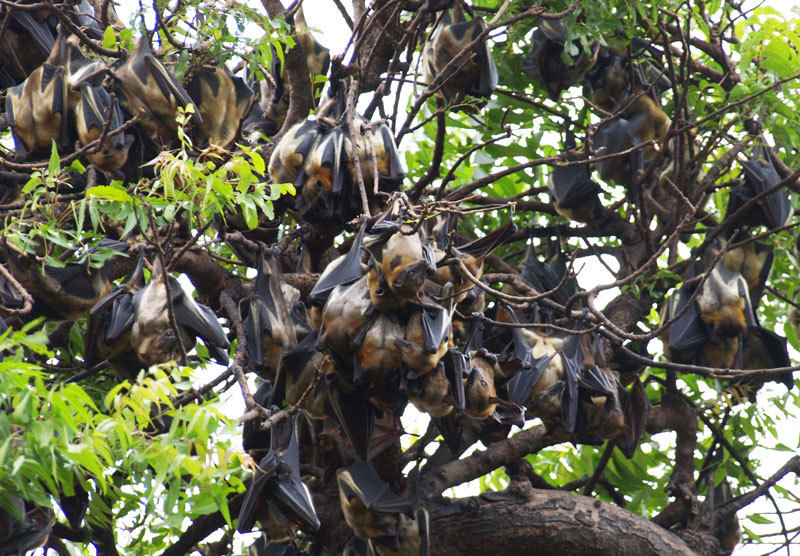

Colony of straw-coloured fruit bats (Eidolon helvum) roosting in Accra, Ghana.
© MPI f. Ornithology/ J. Fahr
African straw-coloured fruit bats fulfil important ecosystem functions by dispersing seeds and pollen during their flights. Researchers from the Max Planck Institute for Ornithology in Radolfzell together with colleagues from Ghana fitted African straw-coloured fruit bats (Eidolon helvum) with GPS-loggers to reveal the routes flown by the animals.
Travel distances differed substantially according to season: during the dry season they covered up to 180 kilometres per night, while distances flown in the wet season was just one-third of this or less. This could be related to variations in population size during these periods.
While the observed colony only consisted of a few thousand individuals during the wet season, in the dry season its population increased to over 100,000 bats. The more bats there are, the greater the competition food, and the further the animals have to fly to find sufficient food supplies.
Every evening as night falls in Accra, a colony of African straw-coloured fruit comes to life. “At first, just a few animals become agitated. Then more and more of them follow suit and a gigantic natural spectacle unfolds,” enthuses Jakob Fahr, who headed the study. “You can almost set your watch by them.”
The animals spend the days hanging upside down in the crowns of old mahogany trees. As soon as the sun sets, the time for resting is over and the entire colony embarks on its search for food: “When the fruit bats take off, the sky darkens” says Fahr. Every evening during the dry season, around 150,000 animals with a wingspan of up to 80 centimetres head off in all directions. They search for fruit and nectar before returning to their day roosts the following morning.
Straw-coloured fruit bats are among the most common bat species found on the African continent. These mammals live in colonies and exhibit pronounced migratory behaviour – presumably due to the seasonal variations in food availability: depending on the dry or wet season, they gather in groups of up to several hundred thousand individuals – as is the case in the Accra colony. At the beginning of the wet season, most bats leave Accra and migrate to northern savannas, leaving just a few thousand individuals behind.
The Radolfzell-based scientists wanted to establish whether the seasonal size variation of the Accra colony has an impact on the bats’ nocturnal foraging behaviour. They hypothesized that a larger colony should lead to longer commuting flights to find sufficient amounts of food.
The scientists were particularly interested in the bats’ nocturnal wanderings because they disperse seeds and pollen in the process and thus fulfil important roles in the continent’s ecosystems. Fahr also refers to the animals in this context as the “Gardeners of the African Forests”. The extent of foraging areas in which the fruit bats perform this “gardening” and how the size of the colony affects it were largely unknown up to now.
The researchers started by catching several individuals using nets and attaching small GPS-loggers to them. “The battery-operated transmitters last up to seven days,” explains Fahr. “At some point, they simply fall off and, if we’re lucky, we’re able to use them again.”
The transmitters record both the routes covered by the bats and acceleration data. This gave the scientists an intimate picture of flight movements between the bats’ roosting and feeding locations. To access the information, the scientists had to visit the colony during the day and collect the recorded data using a receiver. Then the “treasure hunt”, as Fahr calls it, began. Travelling by taxi, the researchers looked for the fruit bat’s feeding sites by following the GPS-coordinates visualized with Google Earth. “Usually you find discarded food remains under the trees”, explains Fahr. This enabled Fahr and his colleagues to identify what the animals had actually eaten – in addition to the flight routes.
Their analyses showed that the enormous colony mainly feeds on nectar during the dry season when the bats commute up to 180 kilometres each night. In contrast, during the wet season, when the colony shrinks to a few thousand individuals, the bats feed almost exclusively on nearby fruits. The average distance travelled falls to around one-third of that covered during the dry season.
The study suggests that African straw-coloured fruit bats compete less for food during the wet season, and for this reason do not fly such long distances during this period. “The fruit available during the dry season may not be sufficient to feed all of the animals. It is also possible that they need certain nutrients during this season and for this reason prefer to feed on nectar.” To clarify this, the scientists would have to quantify food availability in detail.
ny case, the fruit bats provide crucial ecosystem services: their one-way flight routes of up to 90 kilometres make them record-holders among all bat species. During their search for food, they disperse plant seeds across astonishingly large areas. They fly over areas that have been deforested and fragmented by human land use. Moreover, many other seed dispersers have been decimated in many areas due to hunting. “For this reason, fruit bats should not be primarily associated with infectious diseases. They fulfil important ecological roles, without which Africa’s ecosystems would disappear,” says Fahr.
Contact
Dr. Jakob Fahr
Max Planck Institute for Ornithology (Radolfzell), Radolfzell
Phone: +49 531 3912391
Email: jfahr@orn.mpg.de
Mobil: +49 178-14 37 687
Original publication
Jakob Fahr, Michael Abedi-Lartey, Thomas Esch, Miriam Machwitz, Richard Suu-Ire, Martin Wikelski, Dina K. N. Dechmann
Pronounced seasonal changes in the movement ecology of a highly gregarious central-place forager, the African straw-coloured fruit bat (Eidolon helvum).
PLOS One; 14 October, 2015












